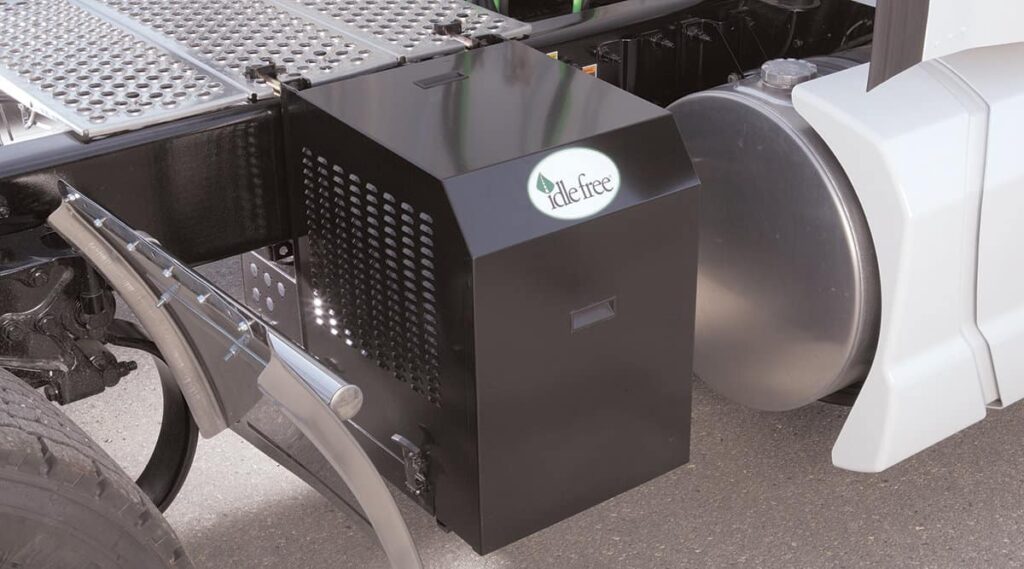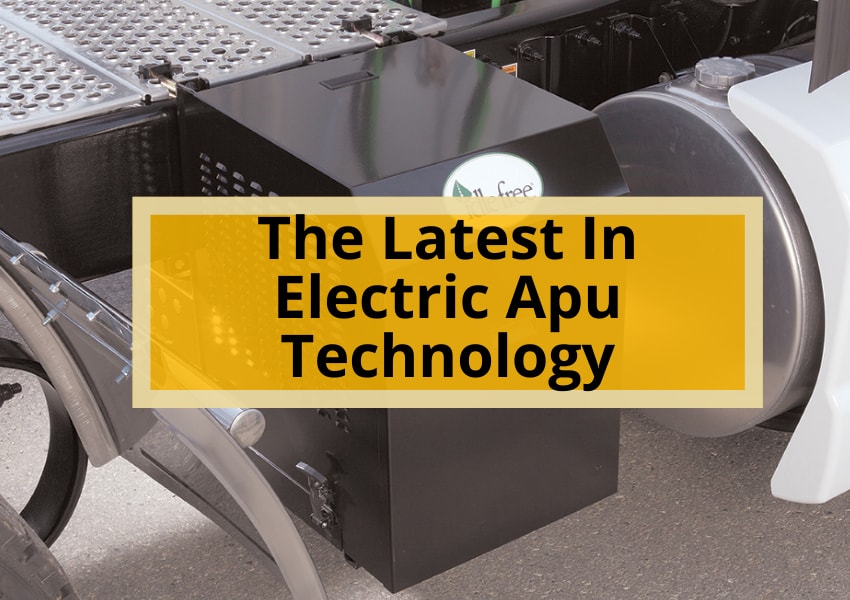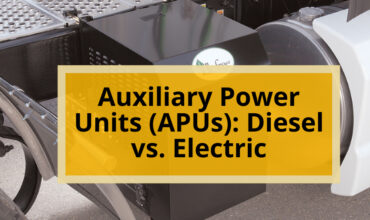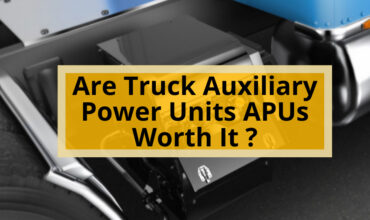In the ever-evolving world of trucking, electric APUs, or battery-powered auxiliary power units, are making waves by revolutionizing truck efficiency. These innovative APUs are designed to reduce emissions, fuel costs, and engine wear, while simultaneously providing power to specific vehicle systems without the need for the engine to be running.
Imagine a truck that can provide air conditioning, heating, and power to other systems, all while the engine remains idle.
One interesting statistic that highlights the impact of electric APUs is that they help with regulatory compliance in areas with anti-idling laws, thus reducing the negative environmental effects of idling trucks. Furthermore, electric APUs extend truck service intervals, control operating costs, and provide a return on investment.
However, it is important to acknowledge the challenges associated with electric APUs, such as lower capacity compared to diesel APUs and the need for continuous power in extreme climate conditions. Nevertheless, the future of battery technology, particularly lithium batteries, holds promise for even greater advancements in energy storage and efficiency.
By adopting electric APUs, the trucking industry can significantly reduce emissions and improve overall efficiency, contributing to a more sustainable future.
What are Electric APUs?
Electric APUs are battery-powered auxiliary power units that provide various vehicle systems with power without the need for the engine to be running, offering benefits such as emissions reduction, fuel cost savings, and reduced engine wear.
These APUs utilize batteries, such as AGM batteries or lithium iron phosphate batteries, to store and provide power. They can provide air conditioning, heating, and power for hotel loads, engine warming, battery charging, and other vehicle systems.
Electric APUs can be integrated with systems like ZeroRPM to provide additional air conditioning operations and cabin heating. They can operate the dash air conditioning, radio, and other systems that are normally run with the engine on.
These APUs help with regulatory compliance in areas with anti-idling laws and contribute to long-term maintenance benefits by reducing wear and tear on the truck engine.

Benefits and Features
The benefits and features of battery-powered auxiliary power units include reduced emissions, fuel cost savings, and extended truck service intervals. Electric APUs can greatly contribute to reducing emissions by allowing specific vehicle systems to operate without the need for the engine to be running. This not only helps with regulatory compliance in areas with anti-idling laws but also improves overall air quality. Additionally, electric APUs can help save on fuel costs by eliminating the need to idle the engine during rest breaks. This can lead to significant fuel savings, especially for long-haul operators. Furthermore, electric APUs can extend truck service intervals, reducing maintenance costs and providing a return on investment. The following table provides a summary of the benefits and features of electric APUs:
| Benefits | Features |
|---|---|
| Reduced emissions | Battery-powered operation |
| Fuel cost savings | Air conditioning and heating capabilities |
| Extended service intervals | Power for various vehicle systems |
This table highlights the key benefits and features of electric APUs, emphasizing their positive impact on emissions, fuel costs, and truck maintenance.
also read : Powering Your Rv: Choosing The Right Generator
Challenges and Considerations
Challenges and considerations surrounding the adoption of battery-powered auxiliary power units (APUs) include the need for continuous power in extreme climate conditions, which can pose difficulties in maintaining optimal performance and battery life.
Electric APUs rely on batteries to store and provide power, and extreme temperatures can negatively impact their performance and lifespan. Furthermore, electric APUs have lower capacity compared to diesel APUs, which may limit their usage in certain applications.
Another consideration is proper battery management, as electric APUs require regular charging and battery changeouts. Additionally, while lithium batteries offer advantages such as longer lifespan and smaller size, they also require specific care and cannot be left out in extreme temperatures.
Despite these challenges, the adoption of electric APUs offers benefits in reducing emissions and improving efficiency, making them a promising solution for enhancing truck efficiency.
Maintenance and Battery Management
Maintenance and battery management are crucial aspects to consider when utilizing battery-powered auxiliary power units (APUs) in order to ensure optimal performance and longevity of the system. Electric APUs have lower maintenance requirements compared to diesel APUs due to their simpler design and fewer moving parts. However, proper battery management is essential for the efficient operation of electric APUs. This includes regular battery checks, monitoring battery charge levels, and ensuring proper battery charging. Battery changeouts are the main maintenance requirement for electric APUs, with AGM batteries requiring replacement every 24-36 months and lithium batteries having a lifespan of at least 10 years. Additionally, different lithium battery chemistries have different safety characteristics, with lithium cobalt batteries being more volatile than lithium iron phosphate batteries. Xantrex utilizes lithium iron phosphate chemistry in their batteries, which are UL Listed for safety. Overall, implementing effective maintenance and battery management practices is crucial for maximizing the benefits of electric APUs and ensuring their long-term reliability and performance.
| Maintenance Tips | Battery Management Tips | Benefits |
|---|---|---|
| Regular battery checks | Monitoring battery charge levels | Maximizing system performance |
| Battery changeouts every 24-36 months for AGM batteries | Ensuring proper battery charging | Extending battery lifespan |
| Choosing lithium iron phosphate batteries for enhanced safety | Utilizing UL Listed batteries | Ensuring system safety |
Future of Electric APUs
Moving forward, the evolution of battery-powered auxiliary power units (APUs) is poised to significantly impact the transportation industry and enhance sustainability efforts. The future of electric APUs holds great promise in terms of improving truck efficiency and reducing emissions.
As technology continues to advance, there is a growing focus on energy storage and battery technologies. Lithium batteries, such as lithium iron phosphate batteries, are being adopted as a replacement for traditional batteries like AGM batteries due to their longer lifespan and improved safety characteristics.
Integrating these battery technologies now not only improves the efficiency and emissions of current APUs but also sets the stage for future electrification adoption. Testing and implementing electric APUs today not only provide valuable feedback for fleet-wide specification but also offer benefits in reducing emissions and improving efficiency across multiple channels.
Frequently Asked Questions
How do electric APUs compare in terms of cost to diesel APUs?
Electric APUs have a higher upfront cost compared to diesel APUs. However, electric APUs offer immediate fuel savings and reduced maintenance requirements, leading to long-term cost control and return on investment.
Can electric APUs be used in extreme climate conditions?
Electric APUs can be used in extreme climate conditions, but they require proper battery management. Lithium batteries, which are commonly used in electric APUs, cannot be left out in extreme temperatures and may require a battery in the sleeper cab.
How long do AGM batteries typically last in electric APUs?
AGM batteries typically last 24-36 months in electric APUs. These batteries, commonly used in electric APUs like the ComfortPro by Carrier Transicold, require regular replacement to ensure optimum performance and power supply for the vehicle systems.
What are the main maintenance requirements for electric APUs?
The main maintenance requirements for electric APUs include battery changeouts, which are necessary every 24-36 months for AGM batteries. Lithium batteries, on the other hand, have a lifespan of at least 10 years, reducing the frequency of replacements.
How do different lithium battery chemistries, such as lithium cobalt and lithium iron phosphate, differ in terms of safety characteristics?
Lithium cobalt batteries, compared to lithium iron phosphate batteries, have higher volatility, making them less safe. Xantrex utilizes lithium iron phosphate chemistry in their batteries, which are UL Listed for safety.






